New Kingdom of Egypt
The New Kingdom, also referred to as the Egyptian Empire, is the period in ancient Egyptian history between the 16th century BC and the 11th century BC, covering the 18th, 19th, and 20th dynasties of Egypt. Radiocarbon dating places the exact beginning of the New Kingdom between 1570 BC and 1544 BC.[1] The New Kingdom followed the Second Intermediate Period and was succeeded by the Third Intermediate Period. It was Egypt's most prosperous time and marked the peak of its power.[2]
New Kingdom | |||||||||||||||
|---|---|---|---|---|---|---|---|---|---|---|---|---|---|---|---|
| c. 1550 BC – c. 1069 BC | |||||||||||||||
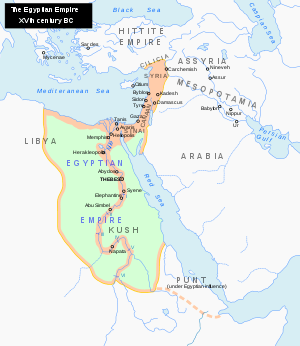 New Kingdom at its maximum territorial extent in the 15th century BC | |||||||||||||||
| Capital |
| ||||||||||||||
| Common languages | Ancient Egyptian, Nubian, Canaanite | ||||||||||||||
| Religion |
| ||||||||||||||
| Government | Divine absolute monarchy | ||||||||||||||
| Pharaoh | |||||||||||||||
• c. 1550 BC – c. 1525 BC | Ahmose I (first) | ||||||||||||||
• c. 1107 BC – c. 1069 BC | Ramesses XI (last) | ||||||||||||||
| History | |||||||||||||||
• Established | c. 1550 BC | ||||||||||||||
• Disestablished | c. 1069 BC | ||||||||||||||
| |||||||||||||||
Part of a series on the |
||||||||||||||||||
|---|---|---|---|---|---|---|---|---|---|---|---|---|---|---|---|---|---|---|
| History of Egypt | ||||||||||||||||||
 | ||||||||||||||||||
|
||||||||||||||||||
|
||||||||||||||||||
|
||||||||||||||||||
|
||||||||||||||||||
|
||||||||||||||||||
|
||||||||||||||||||
|
| ||||||||||||||||||
The concept of a "New Kingdom" as one of three "golden ages" was coined in 1845 by German Egyptologist Baron von Bunsen, and its definition would evolve significantly throughout the 19th and 20th centuries.[3] The later part of this period, under the 19th and 20th Dynasties (1292–1069 BC), is also known as the Ramesside period. It is named after the eleven Pharaohs that took the name Ramesses, after Ramesses I, the founder of the 19th Dynasty.[2]
Possibly as a result of the foreign rule of the Hyksos during the Second Intermediate Period, the New Kingdom saw Egypt attempt to create a buffer between the Levant and Egypt proper, and during this time Egypt attained its greatest territorial extent. Similarly, in response to very successful 17th-century attacks during the Second Intermediate Period by the powerful Kushites,[4] the rulers of the New Kingdom felt compelled to expand far south into Nubia and to hold wide territories in the Near East. In the north, Egyptian armies fought Hittite armies for control of modern-day Syria.
History
Rise of the New Kingdom
The 18th Dynasty included some of Egypt's most famous Pharaohs, including Ahmose I, Hatshepsut, Thutmose III, Amenhotep III, Akhenaten and Tutankhamun. Queen Hatshepsut concentrated on expanding Egypt's external trade by sending a commercial expedition to the land of Punt.
Ahmose I is viewed to be the founder of the 18th dynasty. He continued the campaigns of his father Seqenenre Tao and Kamose against the Hyksos until he reunified the country once more. Ahmose would then continue to campaign in the Levant, the home of the Hyksos, to prevent any future invasions on Egypt.[5]
Ahmose was followed by Amenhotep I, who reigned campaigned in nubia and was followed by Thutmose I. Thutmose I campaigned in the Levant and reached as far as the Euphrates. Thus becoming the first pharoah to cross the river.[6] During this campaign, the Syrian princes declared allegiance to Thutmose. However, after he returned, they discontinued tribute and began fortifying against future incursions.[7]
One of the most powerful pharoahs of this dynasty is queen Hatshepsut. Officially, she ruled jointly with Thutmose III, who had ascended to the throne the previous year as a child of about two years old. Hatshepsut was the chief wife of Thutmose II, Thutmose III's father. Hatshepsut built extensively in the Karnak temple in Luxor and througout all of Egypt [8] and she re-established the trade networks that had been disrupted during the Hyksos occupation of Egypt during the Second Intermediate Period, thereby building the wealth of the Eighteenth Dynasty. She oversaw the preparations and funding for a mission to the Land of Punt. After her death, Thutmose III ruled solely.
Thutmose III ("the Napoleon of Egypt") expanded Egypt's army and wielded it with great success to consolidate the empire created by his predecessors. This resulted in a peak in Egypt's power and wealth during the reign of Amenhotep III. During the reign of Thutmose III (c. 1479–1425 BC), the term Pharaoh, originally referring to the king's palace, became a form of address for the person who was king.[9]
Widely considered a military genius by historians, Thutmose III conducted at least 16 campaigns in 20 years.[10] He was an active expansionist ruler, sometimes called Egypt's greatest conqueror or "the Napoleon of Egypt."[11] He is recorded to have captured 350 cities during his rule and conquered much of the Near East from the Euphrates to Nubia during seventeen known military campaigns. He was the first pharaoh after Thutmose I to cross the Euphrates, doing so during his campaign against Mitanni. He continued north through the territory belonging to the still unconquered cities of Aleppo and Carchemish and quickly crossed the Euphrates in his boats, taking the Mitannian king entirely by surprise.[12]
The wealthiest pharoah of all the pharoahs and this dynasty is Amenhotep III, who built the Luxor Temple, the Precinct of Monthu at karnak and his Massive Morturary Temple. Amenhotep III also built the malkata palace, the largest built in Egypt.
One of the best-known 18th Dynasty pharaohs is Amenhotep IV, who changed his name to Akhenaten in honour of the Aten, a representation of the Egyptian god, Ra. His exclusive worship of the Aten is often interpreted as history's first instance of monotheism. Akhenaten's wife, Nefertiti, contributed a great deal to his new take on the Egyptian religion. Nefertiti was bold enough to perform rituals to Aten. Akhenaten's religious fervour is cited as the reason why he and his wife were subsequently written out of Egyptian history.[13] Under his reign, in the 14th century BC, Egyptian art flourished in a distinctive new style. (See Amarna Period.)
By the end of the 18th Dynasty, Egypt's status had changed radically. Aided by Akhenaten's apparent lack of interest in international affairs, the Hittites had gradually extended their influence into Phoenicia and Canaan to become a major power in international politics—a power that both Seti I and his son Ramesses II would confront during the 19th Dynasty.
The last two members of the Eighteenth Dynasty—Ay and Horemheb—became rulers from the ranks of officials in the royal court, although Ay might also have been the maternal uncle of Akhenaten as a fellow descendant of Yuya and Tjuyu.
Ay may have married the widowed Great Royal Wife and young half-sister of Tutankhamun, Ankhesenamun, in order to obtain power; she did not live long afterward. Ay then married Tey, who was originally Nefertiti's wet-nurse.
Ay's reign was short. His successor was Horemheb, a general during Tutankhamun's reign whom the pharaoh may have intended as his successor in the event that he had no surviving children, which came to pass.[14] Horemheb may have taken the throne away from Ay in a coup d'état. Although Ay's son or stepson Nakhtmin was named as his father/stepfather's Crown Prince, Nakhtmin seems to have died during the reign of Ay, leaving the opportunity for Horemheb to claim the throne next.
Horemheb also died without surviving children, having appointed his vizier, Pa-ra-mes-su, as his heir. This vizier ascended the throne in 1292 BC as Ramesses I, and was the first pharaoh of the Nineteenth Dynasty.
Height of the New Kingdom
The Nineteenth Dynasty was founded by the Vizier Ramesses I, whom the last ruler of the 18th dynasty, Pharaoh Horemheb, had chosen as his successor. His brief reign marked a transition period between the reign of Horemheb and the powerful pharaohs of this dynasty, in particular, his son Seti I and grandson Ramesses II, who would bring Egypt to new heights of imperial power.
Seti I fought a series of wars in western Asia, Libya and Nubia in the first decade of his reign. The main source for Seti’s military activities are his battle scenes on the north exterior wall of the Karnak Hypostyle Hall, along with several royal stelas with inscriptions mentioning battles in Canaan and Nubia. The greatest achievement of Seti I's foreign policy was the capture of the Syrian town of Kadesh and neighboring territory of Amurru from the Hittite Empire. Egypt had not held Kadesh since the time of Akhenaten. Tutankhamun and Horemheb had failed to recapture the city from the Hittites. Seti I was successful in defeating a Hittite army that tried to defend the town. However, The Hittites managed to take it again after Seti's departure.
Ramesses II ("the Great") sought to recover territories in the Levant that had been held by the 18th Dynasty. His campaigns of reconquest culminated in the Battle of Kadesh, where he led Egyptian armies against those of the Hittite king Muwatalli II. Ramesses was caught in history's first recorded military ambush, although he was able to rally his troops and turn the tide of battle against the Hittites thanks to the arrival of the Ne'arin (possibly mercenaries in the employ of Egypt). The outcome of the battle was undecided, with both sides claiming victory at their home front, and ultimately resulting in a peace treaty between the two nations. Egypt was able to obtain wealth and stability under Ramesses' rule of over half a century.[15] His immediate successors continued the military campaigns, although an increasingly troubled court—which at one point put a usurper (Amenmesse) on the throne—made it increasingly difficult for a pharaoh to effectively retain control of the territories.
Ramesses built extensively throughout Egypt and Nubia, and his cartouches are prominently displayed even in buildings that he did not construct.[16] There are accounts of his honor hewn on stone, statues, and the remains of palaces and temples—most notably the Ramesseum in western Thebes and the rock temples of Abu Simbel. He covered the land from the Delta to Nubia with buildings in a way no monarch before him had.[17] He also founded a new capital city in the Delta during his reign, called Pi-Ramesses. It previously had served as a summer palace during Seti I's reign.[18]
Ramesses constructed many large monuments, including the archaeological complex of Abu Simbel, and the Mortuary temple known as the Ramesseum. He built on a monumental scale to ensure that his legacy would survive the ravages of time. Ramesses used art as a means of propaganda for his victories over foreigners, which are depicted on numerous temple reliefs. Ramesses II erected more colossal statues of himself than any other pharaoh, and also usurped many existing statues by inscribing his own cartouche on them.
Ramesses II was also famed for the huge number of children he sired by his various wives and concubines; the tomb he built for his sons, many of whom he outlived, in the Valley of the Kings has proven to be the largest funerary complex in Egypt.
Ramesses' immediate successors continued the military campaigns, though an increasingly troubled court complicated matters. Ramesses II was succeeded by his son Merneptah and then by Merenptah's son Seti II. Seti II's throne seems to have been disputed by his half-brother Amenmesse, who may have temporarily ruled from Thebes.
Upon his death, Seti II's son Siptah, who may have been afflicted with poliomyelitis during his life, was appointed to the throne by Chancellor Bay, a West Asian commoner who served as vizier behind the scenes. At Siptah's early death, the throne was assumed by Twosret, the queen dowager of Seti II and possibly Amenmesse's sister.
A period of anarchy at the end of Twosret's short reign saw a native reaction to foreign control leading to the execution of Bay and the enthronement of Setnakhte, establishing the Twentieth Dynasty.
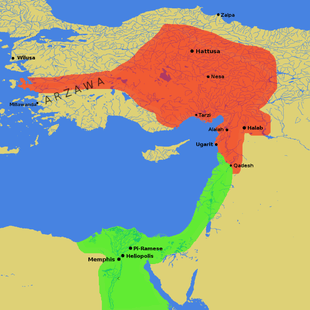 Egyptian and Hittite Empires, around the time of the Battle of Kadesh.
Egyptian and Hittite Empires, around the time of the Battle of Kadesh.
Final years of power
The last "great" pharaoh from the New Kingdom is widely considered to be Ramesses III, a 20th Dynasty pharaoh who reigned several decades after Ramesses II.[19]
In the eighth year of his reign, the Sea Peoples invaded Egypt by land and sea. Ramesses III defeated them in two great land and sea battles (the Battle of Djahy and the Battle of the Delta). He incorporated them as subject peoples and settled them in Southern Canaan although there is evidence that they forced their way into Canaan. Their presence in Canaan may have contributed to the formation of new states, such as Philistia, in this region after the collapse of the Egyptian Empire. He was also compelled to fight invading Libyan tribesmen in two major campaigns in Egypt's Western Delta in his sixth year and eleventh year respectively.[20]
The heavy cost of this warfare slowly drained Egypt's treasury and contributed to the gradual decline of the Egyptian Empire in Asia. The severity of the difficulties is indicated by the fact that the first known labour strike in recorded history occurred during the 29th year of Ramesses III's reign, when the food rations for Egypt's favoured and elite royal tomb-builders and artisans in the village of Deir el Medina could not be provisioned.[21] Air pollutants prevented much sunlight from reaching the ground and also arrested global tree growth for almost two full decades until 1140 BC.[22] One proposed cause is the Hekla 3 eruption of the Hekla volcano in Iceland but the dating of this remains disputed.
Decline into the Third Intermediate Period
Rameses III's death was followed by years of bickering among his heirs. Three of his sons ascended the throne successively as Ramesses IV, Rameses VI and Rameses VIII. Egypt was increasingly beset by droughts, below-normal flooding of the Nile, famine, civil unrest and official corruption. The power of the last pharaoh of the dynasty, Ramesses XI, grew so weak that in the south the High Priests of Amun at Thebes became the de facto rulers of Upper Egypt, and Smendes controlled Lower Egypt even before Rameses XI's death. Smendes eventually founded the 21st Dynasty at Tanis.
Gallery
 Relief of a Nobleman, c. 1295–1070 B.C.E. Brooklyn Museum
Relief of a Nobleman, c. 1295–1070 B.C.E. Brooklyn Museum- Queen Ahmose-Nefertari
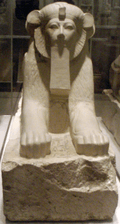 Hatshepsut as a Sphinx. Daughter of Thutmose I, she ruled jointly as her stepson's (Thutmose III) co-regent. She soon took the throne for herself, and declared herself pharaoh.
Hatshepsut as a Sphinx. Daughter of Thutmose I, she ruled jointly as her stepson's (Thutmose III) co-regent. She soon took the throne for herself, and declared herself pharaoh.- Queen Hatshepsut's Temple at Deir el-Bahari, was called Djeser-Djeseru, meaning the Holy of Holies, in ancient times.
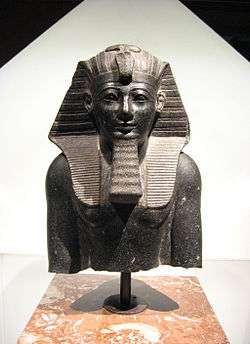 Thutmosis III, a military man and member of the Thutmosid royal line is commonly called the Napoleon of Egypt. His conquests of the Levant brought Egypt's territories and influence to its greatest extent.
Thutmosis III, a military man and member of the Thutmosid royal line is commonly called the Napoleon of Egypt. His conquests of the Levant brought Egypt's territories and influence to its greatest extent.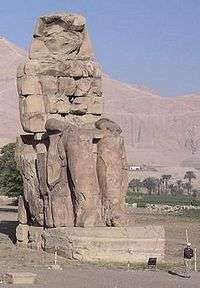 Colossi of Memnon. Representing Amenhotep III, this statue sits outside Luxor.
Colossi of Memnon. Representing Amenhotep III, this statue sits outside Luxor. Tiye, born a commoner, became queen through her marriage to Amenhotep III. In the New Kingdom, women gained influence in court, and Tiye soon helped run affairs of state for both her husband and son during their reigns.
Tiye, born a commoner, became queen through her marriage to Amenhotep III. In the New Kingdom, women gained influence in court, and Tiye soon helped run affairs of state for both her husband and son during their reigns.- Akhenaten, born Amenhotep IV, was the son of Queen Tiye. He rejected the old Egyptian religion and went about promoting the Aten as a supreme deity.
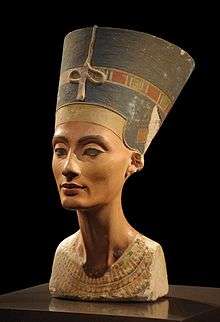 Bust of Nefertiti. The wife of Akhenaten, she held position as co-regent with Akhenaten. She may also have ruled as pharaoh in her own right as she is one of few candidates for the identity of Pharaoh Neferneferuaten.
Bust of Nefertiti. The wife of Akhenaten, she held position as co-regent with Akhenaten. She may also have ruled as pharaoh in her own right as she is one of few candidates for the identity of Pharaoh Neferneferuaten.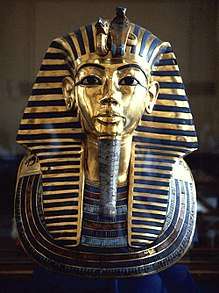 Tutankhamun's mask. King Tutankhamun, son of Akhenaten, restored Egypt to its former religion. Though he died young and was not considered significant in his own time, the 1922 discovery of his KV62 intact tomb by Howard Carter, made him relevant as a symbol of ancient Egypt in the modern world.
Tutankhamun's mask. King Tutankhamun, son of Akhenaten, restored Egypt to its former religion. Though he died young and was not considered significant in his own time, the 1922 discovery of his KV62 intact tomb by Howard Carter, made him relevant as a symbol of ancient Egypt in the modern world.- Detail Temple of Rameses II
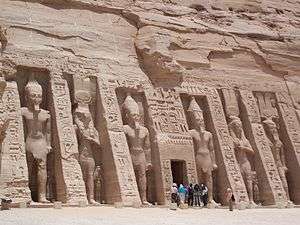 Nefertari's Temple at Abu Simbel
Nefertari's Temple at Abu Simbel Giant Ramses II
Giant Ramses II Abu Simbel Temple of Ramesses II
Abu Simbel Temple of Ramesses II King Tutanhkamun Guardian Statue
King Tutanhkamun Guardian Statue
References
- Christopher Bronk Ramsey et al., Radiocarbon-Based Chronology for Dynastic Egypt, Science 18 June 2010: Vol. 328, no. 5985, pp. 1554–1557.
- Shaw, Ian, ed. (2000). The Oxford History of Ancient Egypt. Oxford University Press. p. 481. ISBN 978-0-19-815034-3.
- Schneider, Thomas (27 August 2008). "Periodizing Egyptian History: Manetho, Convention, and Beyond". In Klaus-Peter Adam (ed.). Historiographie in der Antike. Walter de Gruyter. pp. 181–197. ISBN 978-3-11-020672-2.CS1 maint: ref=harv (link)
- Alberge, Dalya. "Tomb reveals Ancient Egypt's humiliating secret". The Times. London. Retrieved June 14, 2017.
- Weinstein, James M. The Egyptian Empire in Palestine, A Reassessment, p. 7. Bulletin of the American Schools of Oriental Research, n° 241. Winter 1981.
- Shaw and Nicholson (1995) p.289
- Steindorff p.36
- JJ Shirley: The Power of the Elite: The Officials of Hatshepsut's Regency and Coregency, in: J. Galán, B.M. Bryan, P.F. Dorman (eds.): Creativity and Innovation in the Reign of Hatshepsut, Studies in Ancient Oriental Civilization 69, Chicago 2014, ISBN 978-1-61491-024-4, p. 206.
- Redmount, Carol A. "Bitter Lives: Israel in and out of Egypt." p. 89–90. The Oxford History of the Biblical World. Michael D. Coogan, ed. Oxford University Press. 1998.
- Lichtheim, Miriam (2019). Ancient Egyptian Literature. Univ of California Press. p. 340. ISBN 9780520305847. Retrieved 22 October 2019.
- J.H. Breasted, Ancient Times: A History of the Early World; An Introduction to the Study of Ancient History and the Career of Early Man. Outlines of European History 1. Boston: Ginn and Company, 1914, p.85
- Redford War 225
- Tyldesley, Joyce (2005-04-28). Nefertiti: Egypt's Sun Queen. Penguin UK. ISBN 9780141949796.
- Gardiner, Alan (1953). "The Coronation of King Haremhab". Journal of Egyptian Archaeology. 39: 13–31.
- Thomas, Susanna (2003). Rameses II: Pharaoh of the New Kingdom. The Rosen Publishing Group. ISBN 978-0-8239-3597-0.
ramses ii.
- Amelia Ann Blandford Edwards. "Chapter XV: Rameses the Great". Archived from the original on 13 May 2008. Retrieved 23 April 2008.
- Wolfhart Westendorf, Das alte Ägypten, 1969
- Kitchen (1982), p. 119.
- Eric H. Cline and David O'Connor, eds. Ramesses III: The Life and Times of Egypt's Last Hero (University of Michigan Press; 2012)
- Nicolas Grimal, A History of Ancient Egypt, Blackwell Books, 1992. p.271
- William F. Edgerton, "The Strikes in Ramses III's Twenty-Ninth Year", JNES 10, no. 3 (July 1951), pp. 137–145.
- Frank J. Yurco, "End of the Late Bronze Age and Other Crisis Periods: A Volcanic Cause," in Gold of Praise: Studies on Ancient Egypt in Honor of Edward F. Wente, ed: Emily Teeter & John Larson, (SAOC 58) 1999, pp. 456-458.
Further reading
- Bierbrier, M. L. The Late New Kingdom In Egypt, C. 1300-664 B.C.: A Genealogical and Chronological Investigation. Warminster, England: Aris & Phillips, 1975.
- Freed, Rita A., Yvonne Markowitz, and Sue H. d’Auria, eds. Pharaohs of the Sun: Akhenaten, Nefertiti, Tutankhamun. London: Thames & Hudson, 1999.
- Freed, Rita E. Egypt's Golden Age: The Art of Living In the New Kingdom, 1558-1085 B.C. Boston: Museum of Fine Arts, 1981.
- Kemp, Barry J. The City of Akhenaten and Nefertiti: Amarna and Its People. London: Thames & Hudson, 2012.
- Morkot, Robert. A Short History of New Kingdom Egypt. London: Tauris, 2015.
- Radner, Karen. State Correspondence In the Ancient World: From New Kingdom Egypt to the Roman Empire. New York: Oxford University Press, 2014.
- Redford, Donald B. Egypt and Canaan In the New Kingdom. Beʾer Sheva: Ben Gurion University of the Negev Press, 1990.
- Sadek, Ashraf I. Popular Religion In Egypt During the New Kingdom. Hildesheim: Gerstenberg, 1987.
- Spalinger, Anthony John. War In Ancient Egypt: The New Kingdom. Malden, MA: Blackwell Pub., 2005.
- Thomas, Angela P. Akhenaten’s Egypt. Shire Egyptology 10. Princes Risborough, UK: Shire, 1988.
- Tyldesley, Joyce A. Egypt's Golden Empire: The Age of the New Kingdom. London: Headline Book Pub., 2001.
- Wood, Jonathan. R. and Hsu Yi-Ting, An Archaeometallurgical Explanation for the Disappearance of Egyptian and Near Eastern Cobalt-Blue Glass at the end of the Late Bronze Age, Internet Archaeology 52, 2019. Internet Archaeology
External links
| Wikimedia Commons has media related to Egyptian New Kingdom. |
| Wikivoyage has a travel guide for Egyptian Empire. |
| Library resources about New Kingdom of Egypt |
- Middle East on the Matrix: Egypt, The New Kingdom—Photographs of many of the historic sites dating from the New Kingdom
- New Kingdom of Egypt - Aldokkan
| Preceded by Second Intermediate Period |
Time Periods of Egypt 1550–1069 BC |
Succeeded by Third Intermediate Period |